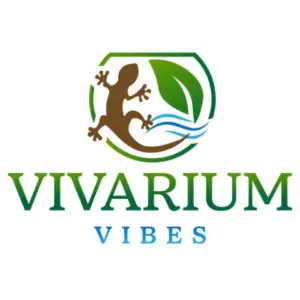This page may contain affiliate links that allow us to make a small commission from qualifying purchases (at no extra cost to yourself). We appreciate your support.
When choosing plants for your paludarium it is important to understand the different elements within a paludarium environment. A paludarium includes the best of both worlds and combines both aquatic and terrestrial elements, to create the ultimate habitat. As I am relatively new to paludariums, I decided to do some research and find out exactly which plants are best suited to each environment factor within a paludarium.
Through my research I discovered that paludarium plants can be divided into three distinct categories: aquatic plants, semi-aquatic plants, and terrestrial plants. Within this article, you will see my top choices for plants associated with each category that will help you build the perfect paludarium.
As an added bonus, I have also included 130+ alternative options which can be found in the paludarium plant summary table at the end of this article.
Helpful Tip:
“spp.” means multiple species
The abbreviation, spp, is botanical shorthand for multiple species. So, if you see “Cryptocoryne spp.” it means that the reference is for two or more Cryptocoryne species.
1. Indian Toothcup (Rotala indica)
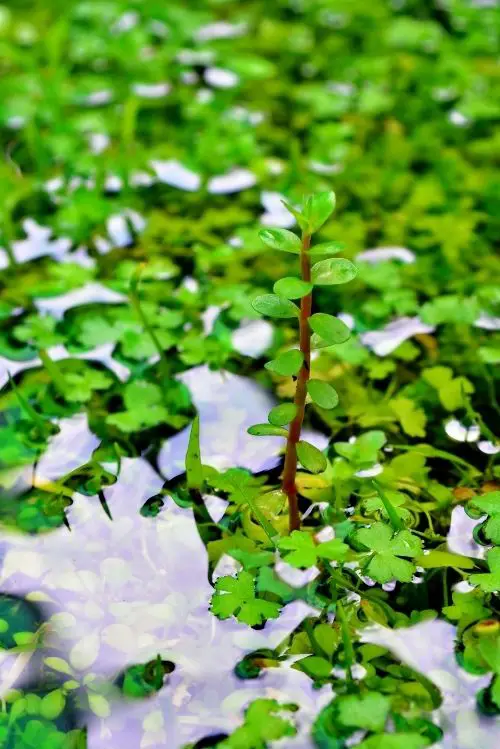
The Indian Toothcup is an aquatic stem plant that would be best suited in the mid-ground to background of the aquarium section of your paludarium. This plant typically has a moderate level of maintenance required due it its higher light requirements. For optimal growth, it is advised to provide 3 to 5 watts of full spectrum bulbs (5000-7000k) per gallon of water provided. The Indian Toothcup poses no danger to living creatures and is best suited as a background plant.
| Common Name | Indian Toothcup |
| Scientific Name | Rotala indica |
| Environment Type | Aquatic |
| Plant Type | Stem |
| Placement | Mid to Background |
Below is a short list of additional aquatic stem plants that could also be used in a Paludarium:
- Brazillian Pennywort (Hydrocotyle Leucocephala)
- Scarlet Temple (Alternanthera Reineckii)
- Miramar weed (Hygrophila Polysperma)
- Temple Plant (Hygrophila Corymbosa)
- Willow Hygro (Hygrophila Angustifolia)
- Water Thyme (Hydrilla Verticillata)
- Bacopa (Hedyotis Salzmannii)
- Water Primrose (Ludwigia Repens)
- Ludwigia Glandulosa (Ludwigia Peruensis)
- Staurogyne Repens
- Anacharis (Egeria densa)
- Dwarf Four Leaf Clover (Marsilea Hirsuta)
- Monte Carlo (Micranthemum Tweediei)
- Giant Red Rotala (Rotala Macrandra)
- Crystalwort (Riccia fluitans)
- Water Wisteria (Hygrophila difformis)
- Glosso (Glossostigma Elatinoides)
2. American Waterweed (Elodea canadensis)
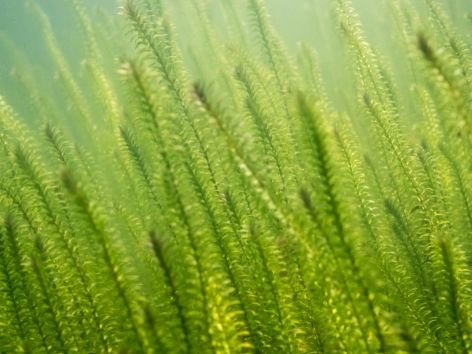
Elodea canadensis, commonly known as the American Waterweed, is a great choice for a Paludarium as they are sturdy and can produce high levels of oxygen. Healthy Paludarium systems need oxygen to thrive so this plant is perfect. Elodea plants are a type of dioecious plant, which means they are able to produce both male and female flowers. Their multi-branch stems provide great coverage for shy fish or other small animals.
| Common Name | American Waterweed |
| Scientific Name | Elodea canadensis |
| Environment Type | Aquatic |
| Plant Type | Perennial |
| Placement | Background |
3. Duckweed (Lemna Minor)
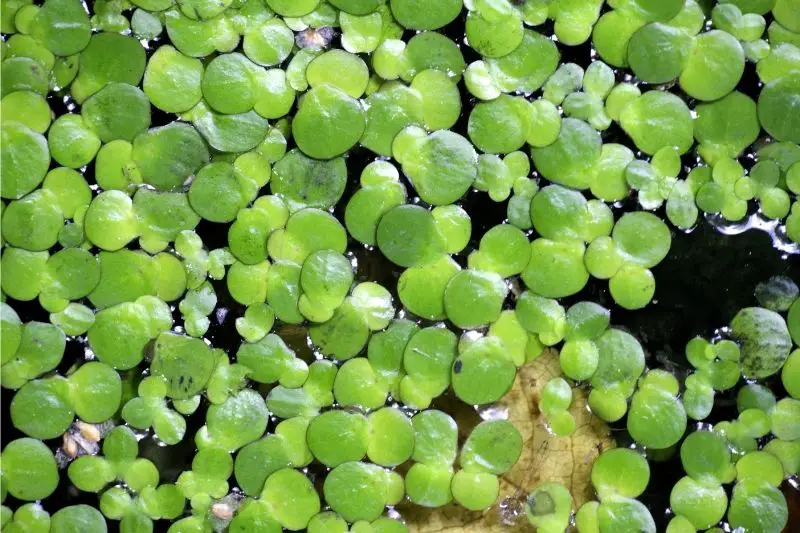
Common Duckweed is one of the smallest flowering plants in the world and can be a great addition to the water surface of your Paludarium. You only need one small plant, which looks like a small leaf, floating on the surface of the water. One single plant produces two plantlets, which can then start to rapidly produce new offshoots. Common Duckweed can be a great food source for your fish and also provide plenty of cover from any terrestrial animals within your Paludarium that may like to go fishing.
| Common Name | Common Duckweed |
| Scientific Name | Lemna Minor |
| Environment Type | Aquatic |
| Plant Type | Floating |
| Placement | Water Surface |
Below is a short list of additional aquatic floating plants that could also be used in a Paludarium:
- Amazon frogbit (Limnobium laevigatum)
- Mosquito Fern (Azolla Filiculoides)
- Crystalwort (Riccia fluitans)
- Water Spangles (Salvinia Minima)
- Floating Fern (Salvinia Natans)
- Banana Lily (Nymphoides Aquatica)
- Hornwort (Ceratophyllum Demersum)
- Dwarf Aquarium Lily (Nymphaea Stellata)
- Dwarf Water Lettuce (Pistia stratiotes)
- Guppy grass (Najas guadalupensis)
- Red root floater (Phyllantus fluitans)
- Water hyacinth (Eichhórnia crássipes)
4. Crystalwort (Riccia fluitans)
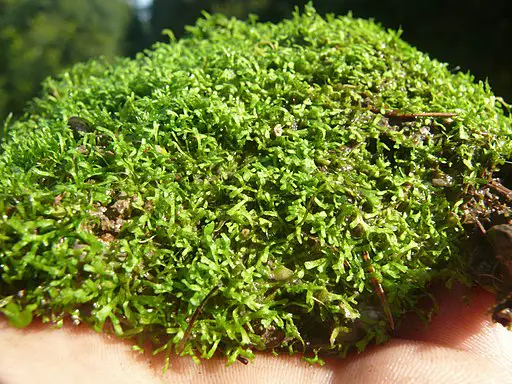
Crystalwort is typically used as a floating plant but can be submerged at the bottom of the water if you tie the plant to a stone using fishing line. Crystalwort can provide great coverage and protection for young fish due to its bushy nature. This plant is extremely easy to maintain and requires a low to medium light source.
| Common Name | Crystalwort |
| Scientific Name | Riccia fluitans |
| Environment Type | Aquatic |
| Plant Type | Floating |
| Placement | Water Surface or Mid-ground if anchored |
5. Buce Plant (Bucephalandra)
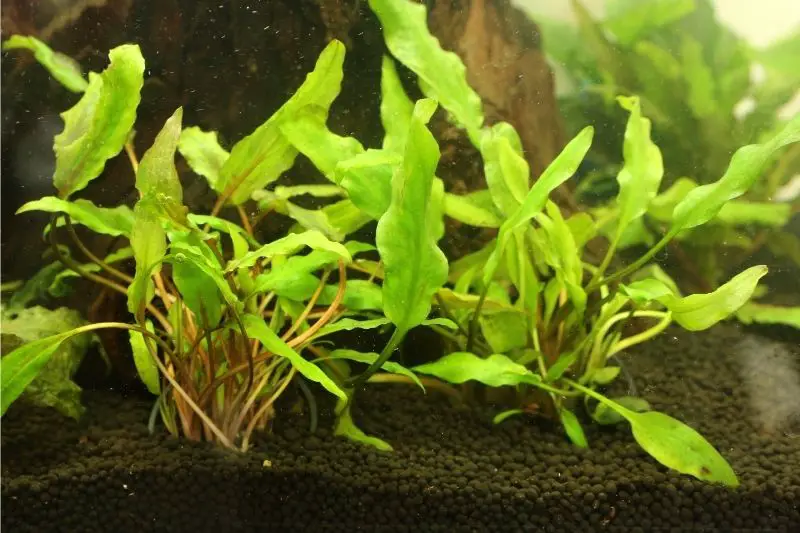
The Buce plant best fits in the foreground or mid-ground in the water section of your Paludarium. In order to keep your plant healthy and strong, be sure that your Paludarium has sufficient water circulation. A simple water filter will do the trick as the Buce plant naturally grows in fast-flowing rivers. Low light conditions would best suit this plant if you want to slow the growing process and keep it contained below water levels. If you would prefer quicker growth and stronger coloration then use medium to high levels of light.
| Common Name | Buce Plant |
| Scientific Name | Bucephalandra |
| Environment Type | Aquatic |
| Plant Type | Araceae |
| Placement | Mid to Foreground |
6. Eelgrass (Zostera)
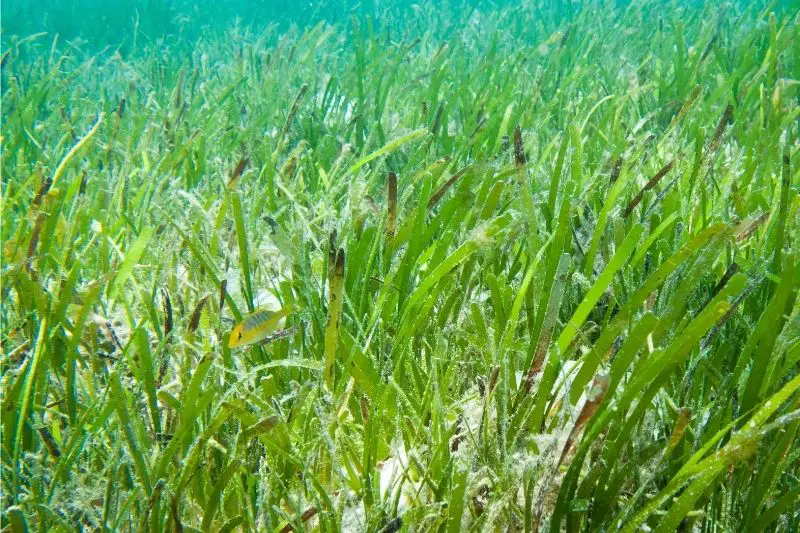
Eelgrass, which is often referred to simply as “seagrass”, is a submerged aquatic plant that is often used to provide additional coverage for your fish or snails within your Paludarium. The best placement for eelgrass is in the foreground of your tank to allow for easier access to light. Some of the benefits for including eelgrass in your tank is that their nutrients help to improve water clarity, provide more oxygen, and reduce algae growth.
| Common Name | Eelgrass |
| Scientific Name | Zostera |
| Environment Type | Aquatic |
| Plant Type | Seagrass |
| Placement | Foreground |
7. Cryptocoryne spp.
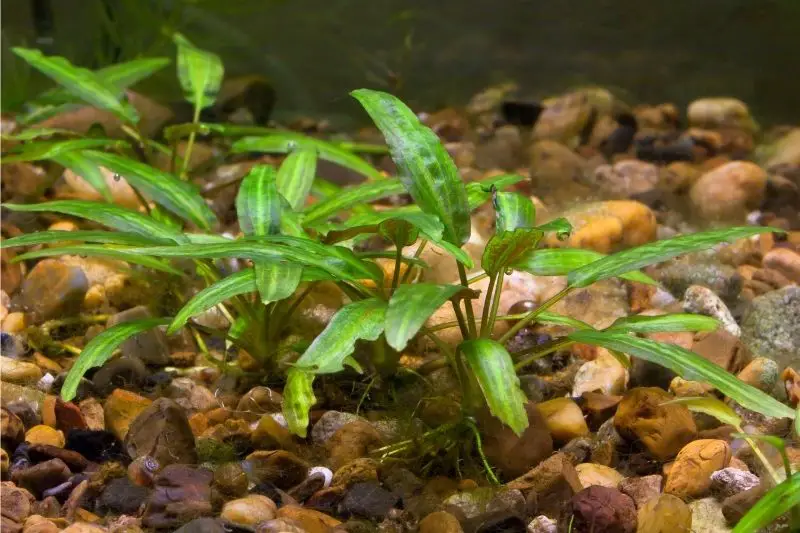
This aquatic marginal plant is great for beginners and fits well into any type of paludarium. I would suggest placing this plant in the middle to background of the water sections of your paludarium. Although Cryptocoryne, aka “Crypts”, has very low maintenance requirements, one thing to be aware of is that these plants like consistency. Planting and re-planting Crypts on a regular basis will cause the leaves to die and enable slow growth. As Crypt leaves are quite soft, they may be a prime choice for any plant eating fish within your Paludarium.
| Common Name | Cryptocoryne |
| Scientific Name | Cryptocoryne spp. |
| Environment Type | Aquatic |
| Plant Type | Marginal Plant |
| Placement | Mid to Background |
Below is a short list of additional aquatic and semi-aquatic marginal plants that could also be used in a Paludarium:
- Amazon Sword (Echinodorus grisebachii)
- Anubias (Anubias)
- Dwarf Lobelia Cardinal (Lobelia Cardinal)
- Broad-Leaf Sagittaria (Sagittaria Chilensis)
- Magic Bulb (Aponogeton Ulvaceus)
- Narrow-Leaved Arrowhead (Dwarf Sagittaria Subulata)
- Pondweed (Potamogeton Spp.)
- Needle Spike Rush (Eleocharis Parvula)
- Micro Sword (Lilaeopsis brasiliensis)
8. Amazon Frogbit (Limnobium laevigatum)
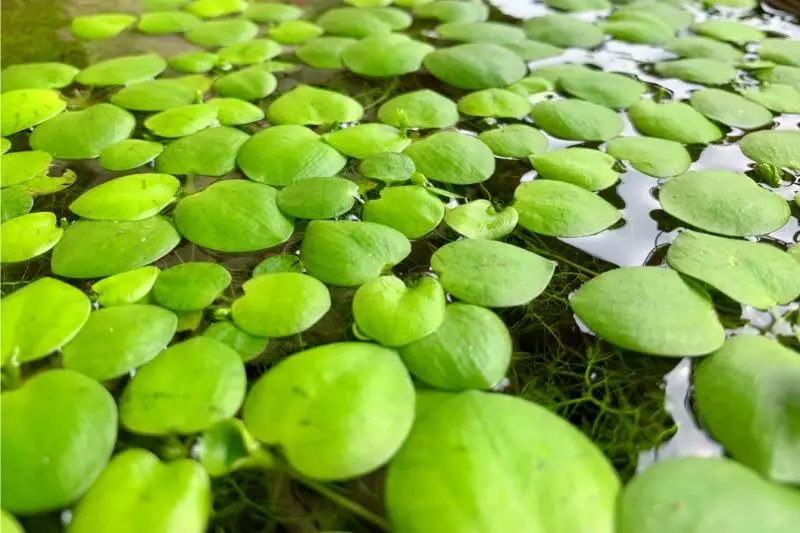
The Amazon Frogbit, also known as the South American spongeplant, can be another great addition if your looking to add some water surface cover to your Paludarium. This plant is often a favorite among species of aquatic snails as they like to eat the spongy part of the plant on the bottom of the leaves.
There are, however, a couple of things to keep in mind when introducing this plant into your Paludarium. If left uncontrolled, the plant can grow too quickly and become quite invasive. As the leaves are quite dense, due to the spongy material under the plant leaves, it can be hard for adequate oxygen and light levels to penetrate the water surface. This could potentially alter the habitat structure and decrease biodiversity. Also, long-lasting water droplets on the tops of the plant leaves can cause the plant to rot, so be sure that the tops of the plant leave remain dry.
| Common Name | Amazon Frogbit |
| Scientific Name | Limnobium laevigatum |
| Environment Type | Aquatic |
| Plant Type | Floating |
| Placement | Water Surface |
Below is a short list of additional aquatic floating plants that could also be used in a Paludarium:
- Common Duckweed (Lemna Minor)
- Mosquito Fern (Azolla Filiculoides)
- Crystalwort (Riccia fluitans)
- Water Spangles (Salvinia Minima)
- Floating Fern (Salvinia Natans)
- Banana Lily (Nymphoides Aquatica)
- Hornwort (Ceratophyllum Demersum)
- Dwarf Aquarium Lily (Nymphaea Stellata)
- Dwarf Water Lettuce (Pistia stratiotes)
- Guppy grass (Najas guadalupensis)
- Red root floater (Phyllantus fluitans)
- Water hyacinth (Eichhórnia crássipes)
9. Bladderwort (Utricularia)
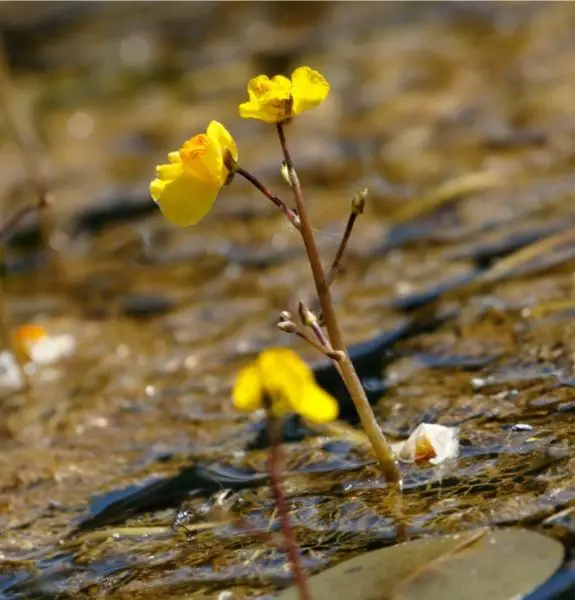
Bladderworts require some extra attention and may not be best suited for an absolute beginner. The main issue people tend to have is a lack of CO2 (Carbon Dioxide) within their tank. This will cause the plant to wilt and grow slowly. The best solution is to use a CO2 supply within your tank so that you can be sure your plant is getting the care it needs.
My top choice is this CO2 Diffuser from Amazon. It is non-invasive and can help to improve the growth and health of your plants by providing a sufficient CO2 supply.
Bladderworts can be either emersed or submerged within the water and are best planted in soil made of sand and gravel. Be sure to plant near your light source as they require medium to strong levels of light to thrive.
| Common Name | Bladderwort |
| Scientific Name | Utricularia |
| Environment Type | Aquatic |
| Plant Type | Carnivorous |
| Placement | Foreground |
10. Java Fern (Microsorum pteropus)
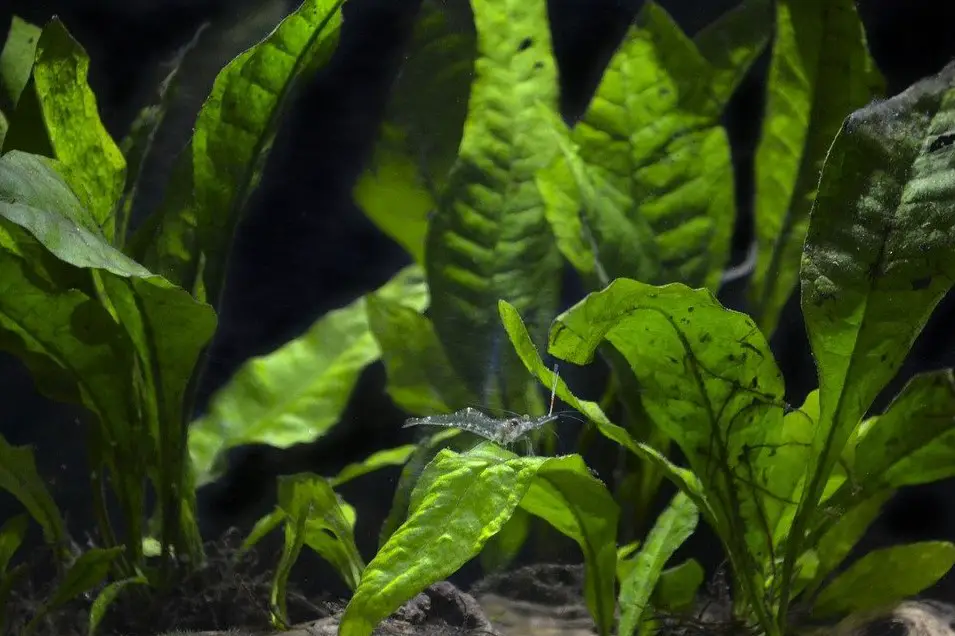
The Java Fern is a great plant choice for any Paludarium as they are easy to maintain and thrive in underwater conditions. When planting your Java fern, be sure to use wood or rocks instead of soil as Java ferns contain epiphytic roots and prefer things they can attach themselves to. Unlike some other plants, Java ferns prefer low-light conditions as their leaves can burn if they are exposed to too much light.
| Common Name | Java Fern |
| Scientific Name | Microsorum pteropus |
| Environment Type | Aquatic |
| Plant Type | Fern |
| Placement | Mid to Background |
Below is a short list of additional aquatic fern plants that could also be used in a Paludarium:
- Broad-Leaf Water Sprite (Ceratopteris Cornuta)
- Water Sprite Plant (Ceratopteris Thalictroides)
- African water fern (Bolbitis Heudelotii)
11. Java Moss (Taxiphyllum Barbieri)
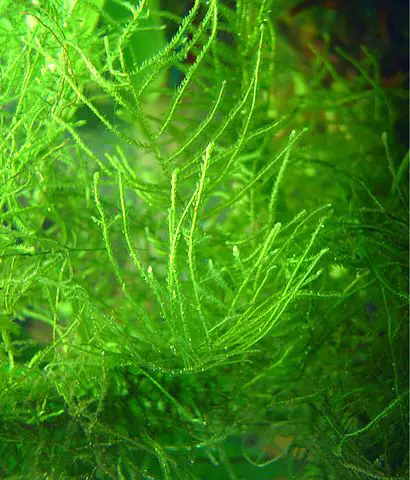
Java Moss is a great fit for any Paludarium as it is extremely easy to care for and only requires occasional trimming as desired. It goes perfectly with any tanks that contain shrimp or other small fish as it provides great coverage and food in the form of biofilm. The most common problem that you may encounter with Java Moss, is algae growth.
As the strands of Java Moss are so fine, it can be difficult to clean the plant from algae if it becomes excessive. The best solution, if discovered, is to just discard the affected portion of the plant. The best way to prevent algae growth within your Java Moss, is to keep the water clean and avoid too much light.
| Common Name | Java Moss |
| Scientific Name | Taxiphyllum Barbieri |
| Environment Type | Aquatic |
| Plant Type | Moss |
| Placement | Mid to Foreground |
Below is a short list of additional aquatic moss that could also be used in a Paludarium:
- Christmas Moss (Vesicularia montagnei)
- Phoenix Moss (Fissidens Fontanus)
- Taiwan Moss (Taxiphyllum Alternans)
12. Christmas Moss (Vesicularia montagnei)
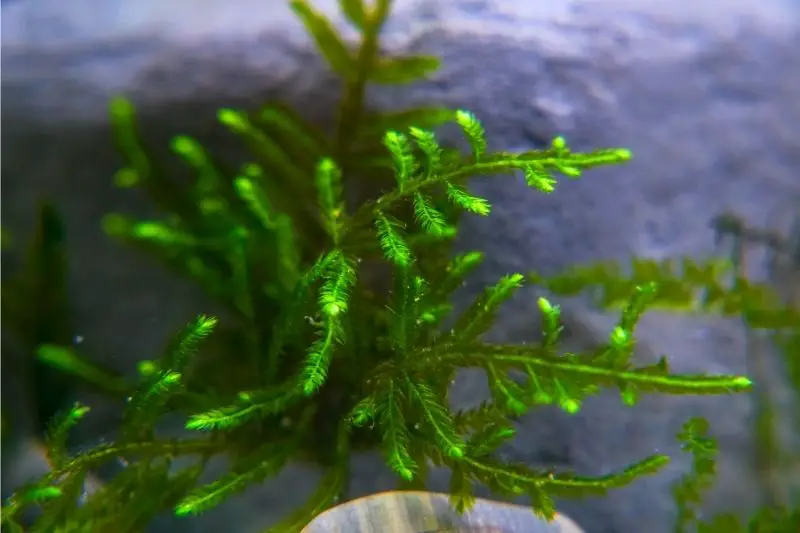
Christmas moss is a great alternative to Java Moss and thrives best when fully submerged and placed close to the water flow of your filtration system. Most aquatic moss does better with good water movement as it replicates its natural environment and encourages healthy growth. Christmas moss pairs well with small fish and shrimp that like to eat algae as they are small enough to not damage your plant. Be sure to use bright light, as this will encourage better growth as slow to medium light will slow the growth of your moss and could lead to rot.
As Christmas moss grows horizontally instead of vertically, it is often used as a type of carpet or moss wall within your tank. You don’t need substrate for this plant to grow as it naturally will latch on to its nearby surroundings. One thing to keep in mind, is that Christmas Moss is a freshwater plant and will not survive in salt water.
| Common Name | Christmas Moss |
| Scientific Name | Vesicularia montagnei |
| Environment Type | Aquatic |
| Plant Type | Moss |
| Placement | Mid to Background |
13. Brazilian Pennywort (Hydrocotyle Leucocephala)
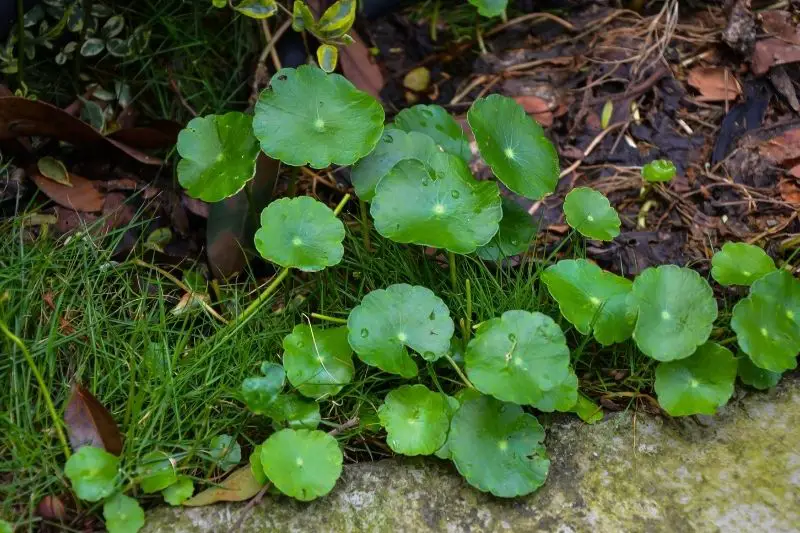
The Brazilian Pennywort is recommended for a tank size of at least 10 gallons and although it is primarily an aquatic stem plant, it also makes for a great floating plant. This is one reason why i think this plant is great for Paludariums as it provides you with many different options. Although the Brazilian Pennywort is easy to maintain, it can grow rather quickly, so be sure to trim as needed. The roots of the plant can be rather delicate but do provide good coverage for small fish or snails.
| Common Name | Brazilian Pennywort |
| Scientific Name | Hydrocotyle Leucocephala |
| Environment Type | Aquatic |
| Plant Type | Stem |
| Placement | Mid to Background |
Below is a short list of additional aquatic stem plants that could also be used in a Paludarium:
- Indian Toothcup (Rotala indica)
- Scarlet Temple (Alternanthera Reineckii)
- Miramar weed (Hygrophila Polysperma)
- Temple Plant (Hygrophila Corymbosa)
- Willow Hygro (Hygrophila Angustifolia)
- Water Thyme (Hydrilla Verticillata)
- Bacopa (Hedyotis Salzmannii)
- Water Primrose (Ludwigia Repens)
- Ludwigia Glandulosa (Ludwigia Peruensis)
- Staurogyne Repens
- Anacharis (Egeria densa)
- Dwarf Four Leaf Clover (Marsilea Hirsuta)
- Monte Carlo (Micranthemum Tweediei)
- Giant Red Rotala (Rotala Macrandra)
- Crystalwort (Riccia fluitans)
- Water Wisteria (Hygrophila difformis)
- Glosso (Glossostigma Elatinoides)
14. Amazon Sword (Echinodorus grisebachii)
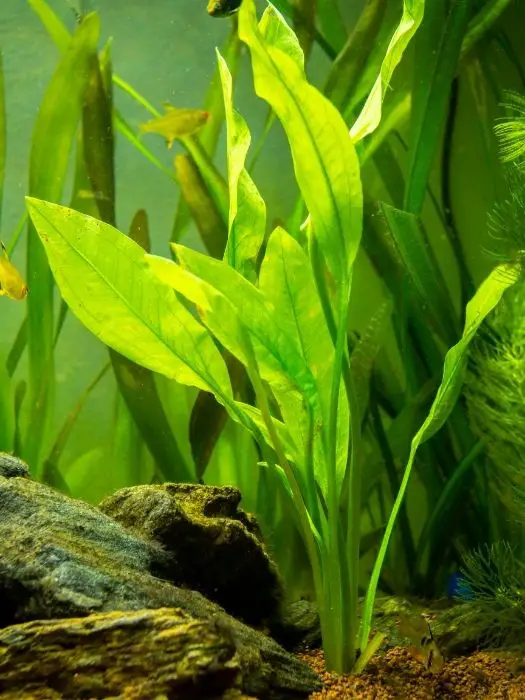
The Amazon sword is a great aquatic plant that can be used in Paludariums or aquariums. It will help keep the water clean and remove any unwanted compounds. The Amazon sword plant can be prone to algae growth so be sure to follow standard lighting requirements. Standard lighting requirements for this type of plant is around 11-12 hours of light a day which can be produced by any sort of lamp or sunlight.
The Amazon Sword pairs well with most fish and tank mates, just be weary of energetic fish as they may cause damage to your plants leaves. For healthy growth and longevity, be sure to plant in at least 2.5 inches of substrate. This will ensure your plant is well grounded and can withstand your tanks water flow and curiosity of its inhabitants.
| Common Name | Amazon Sword |
| Scientific Name | Echinodorus grisebachii |
| Environment Type | Aquatic |
| Plant Type | Marginal Plant |
| Placement | Mid to Background |
Below is a short list of additional aquatic and semi-aquatic marginal plants that could also be used in a Paludarium:
- Cryptocoryne (Cryptocoryne)
- Anubias (Anubias)
- Dwarf Lobelia Cardinal (Lobelia Cardinal)
- Broad-Leaf Sagittaria (Sagittaria Chilensis)
- Magic Bulb (Aponogeton Ulvaceus)
- Narrow-Leaved Arrowhead (Dwarf Sagittaria Subulata)
- Pondweed (Potamogeton Spp.)
- Needle Spike Rush (Eleocharis Parvula)
- Micro Sword (Lilaeopsis brasiliensis)
15. Blue Water Hyssop (Bacopa caroliniana)
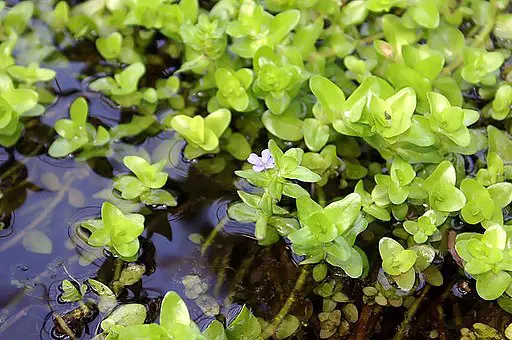
The Blue Water Hyssop is a great fit for paludariums as they have strong stems which provide great coverage for fish and snails. They are also a flowering plant, and can provide color on your tanks water surface if well maintained. They are a great plant for beginners and can withstand most environments, with very little maintenance. Common problems to look out for are melting/dying leaves, rapid growth, and lack of nutrients.
If signs of melting occur, just trim the dead parts of the leaves to stop the rest of the plant from dying. Monitor your plants growth and trim when necessary and you should be able to avoid any overgrowth which could damage your other plants and crowd your tank. Make sure your tank is cleaned appropriately and your plants receive the nutrients they require and you should have nothing to worry about!
| Common Name | Blue Water Hyssop |
| Scientific Name | Bacopa caroliniana |
| Environment Type | Semi-Aquatic |
| Plant Type | Stem |
| Placement | Background |
Below is a couple of additional semi-aquatic stem plants that could also be used in a Paludarium:
- Parrot’s Feather (Myriophyllum Aquaticum)
- Dwarf baby tears (Hemianthus callitriodes)
16. Lucky Bamboo (Dracaena Braunii)
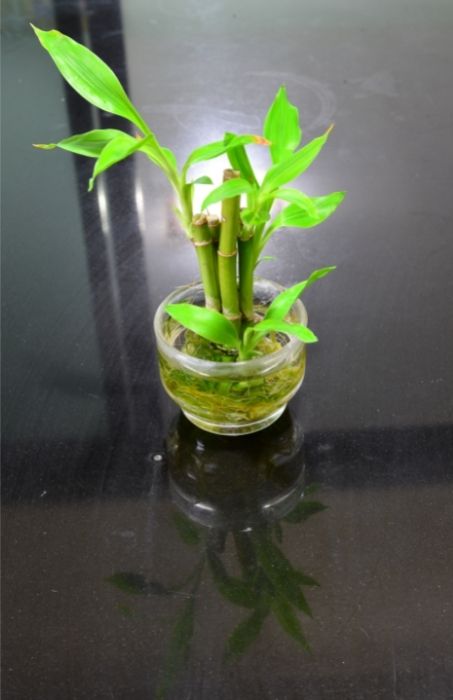
Lucky bamboo is the perfect plant to provide sturdy climbing branches for your reptiles to climb on due to their long bamboo stems that sprout vertical leaves. They are great for semi-aquatic paludariums or reptile enclosures and grow best when placed in shallow water with pebbles.
Dracaena Braunii is often confused with the more common Dracaena sanderiana. They are both known as the Lucky Bamboo plant but do contain some differences. The key difference is that the Dracaena Braunii has flowers and leaves 5 times shorter than that of the Dracaena sanderiana. Although both can be used in your paludarium, the Dracaena Braunii would be better suited for smaller paludariums and will be easier to contain.
| Common Name | Lucky Bamboo |
| Scientific Name | Dracaena Braunii |
| Environment Type | Semi-Aquatic |
| Plant Type | Houseplant |
| Placement | Mid to Background |
Below is a couple of additional semi-aquatic houseplants that could also be used in a Paludarium:
- Peace Lily (Spathiphyllum)
- Paper Reed (Cyperus Papyrus)
- Heartleaf Philodendron (Philodendron Cordatum)
17. Peace Lily (Spathiphyllum)
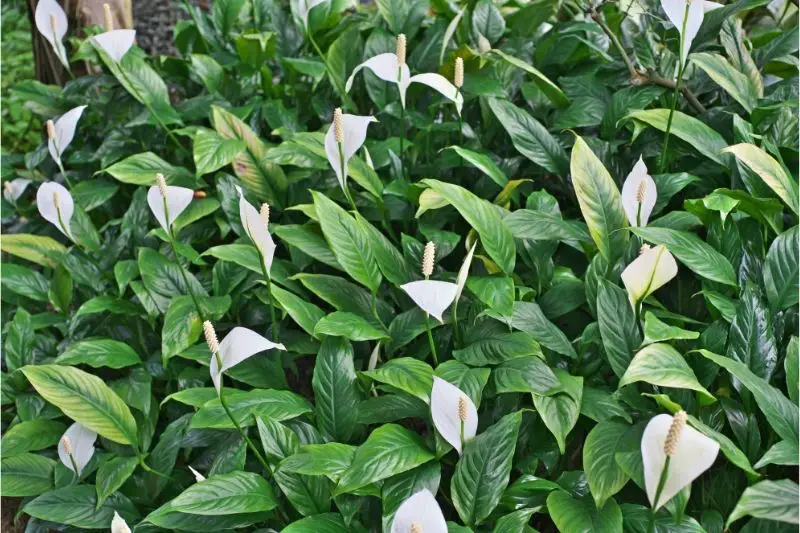
When placing the Peace Lily in your paludarium, make sure that only the roots of the plant are submerged in water. Keep the base of the plant and leaves above water as there is a high risk of your plant developing root rot if the base plant or leaves remain constantly wet.
One thing to keep in mind is that the Peace Lily is mildly poisonous and may cause stomach and respiratory irritation if it is ingested. All parts of the plant contain calcium oxalate so be sure to only use in paludariums where you won’t have any reptiles or other living creatures tempted to eat the plant in large quantities.
| Common Name | Peace Lily |
| Scientific Name | Spathiphyllum |
| Environment Type | Semi-Aquatic |
| Plant Type | Houseplant |
| Placement | Roots in water, plant above water |
18. Creeping Jenny (Lysimachia nummularia)
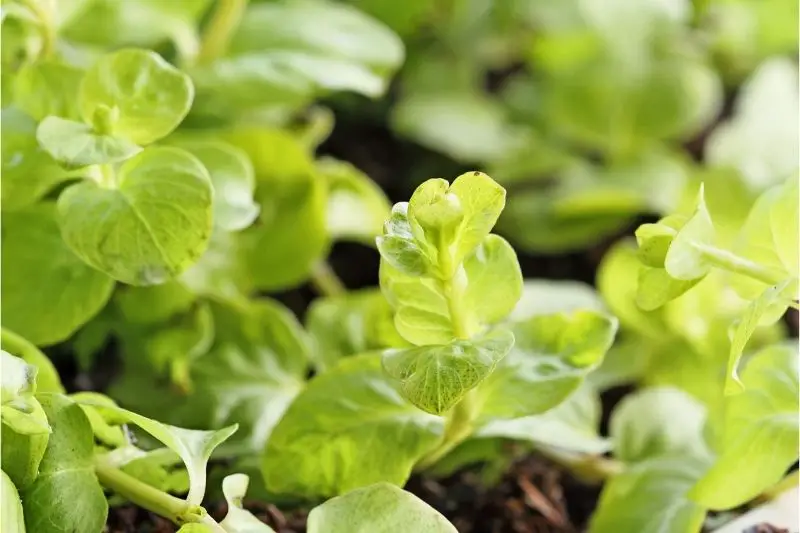
Creeping Jenny is extremely hardy and can be used almost anywhere within your paludarium. It can provide great coverage for small fry or be used on the water surface to lower your tanks light exposure. One of the most common problems to keep an eye out for is algae growth.
Algae growth can overtake your plants and prevent them from growing. To prevent algae growth, be sure to keep a balanced ecosystem and that your plants are receiving the appropriate light and nutrient requirements.
Creeping Jenny (Lysimachia nummularia) is often confused with the very similar Moneywort plant (Bacopa monnieri). Although these plants are often referred to each other interchangeably, there are some slight differences.
The best way to tell the difference between the two is by their flower color. Creeping Jenny has bright yellow flowers and the Moneywort has small white flowers.
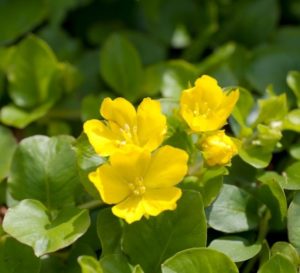
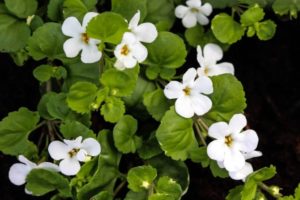
If the plant does not have flowers yet then pay attention to the color of the stems and leaves. Creeping Jenny will have a more golden-green color to it and Moneywort leaves and stems will be a darker lime-green.
| Common Name | Creeping Jenny |
| Scientific Name | Lysimachia nummularia |
| Environment Type | Semi-Aquatic |
| Plant Type | Vine |
| Placement | Background or Water Surface |
Below is a couple of additional semi-aquatic vine plants that could also be used in a Paludarium:
- Philodendron Brasil (Philodendron Hederaceum)
- Trailing Daisy (Wedelia Trilobata)
19. Anubias (Anubias)
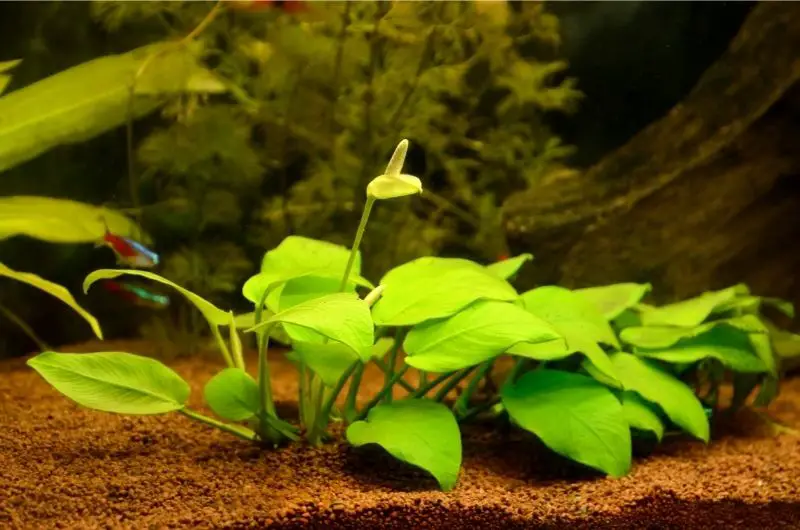
The Anubias plant genus is most often used in aquariums and is fully submerged. What a lot of people don’t realize however, is that this plant can also do quite well above water in a terrarium or paludarium. The great thing about using the Anubias in a paludarium, is that you can have the best of both worlds!
The Anubias barteri is the most common species used as it is easily accessible and affordable. The Anubias requires very little light and maintenance and can also be attached to a plank of wood or other object that will allow the plant to grow emersed if desired. Anubias are great at helping keep your water healthy and clean by increasing oxygen and controlling nitrate levels.
Anubias leaves are quite sturdy and strong and so pretty much any tank mates will work well. Herbivore fish tend to stay away from these plants and so it is a must have for any tank with cichlids.
| Common Name | Anubias |
| Scientific Name | Anubias |
| Environment Type | Semi-Aquatic |
| Plant Type | Marginal Plant |
| Placement | Foreground to Background |
20. Parrot’s Feather (Myriophyllum Aquaticum)
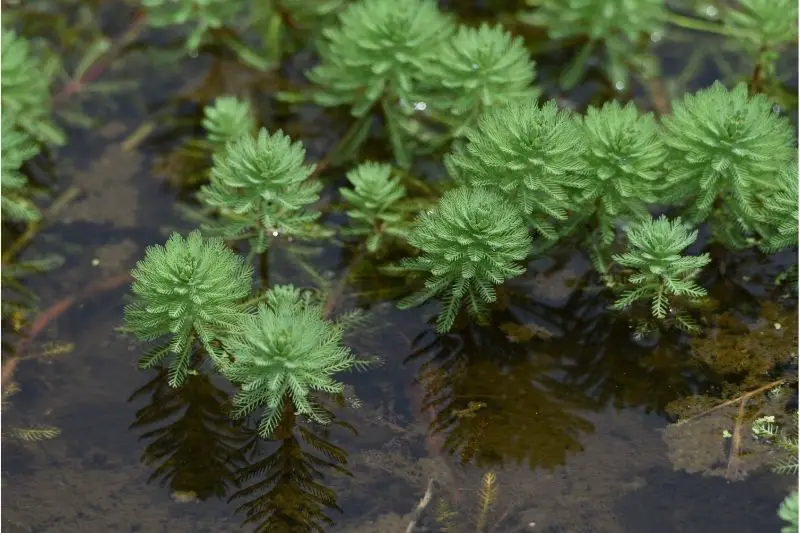
Parrot’s Feather is a great plant choice for Paludariums as it can be planted both below the water surface or above. The plant gets its name from the feather like characteristics that sprout from its stems, which is a lot more noticeable if the plant is emerged.
Maintenance for the Parrot’s Feather is a little more involved than your average paludarium plant and so be sure you are up for the task if you decide to use them in your habitat. This plant requires heavy light to grow steadily and does best with supplemental CO2.
My top choice is this CO2 Diffuser from Amazon. It is non-invasive and can help to improve the growth and health of your plants by providing a sufficient CO2 supply.
| Common Name | Parrot’s Feather |
| Scientific Name | Myriophyllum Aquaticum |
| Environment Type | Semi-Aquatic |
| Plant Type | Stem |
| Placement | Background |
Below is a couple of additional semi-aquatic stem plants that could also be used in a Paludarium:
- Blue Water Hyssop (Bacopa caroliniana)
- Dwarf baby tears (Hemianthus callitriodes)
So now we have arrived at the terrestrial part of this article. The following plants should be planted in the land portion of your paludarium as they will not do well if submerged in water. The following plants will need a good substrate to be planted in relative to their needs.
21. Nerve Plant (Fittonia Albivenis)
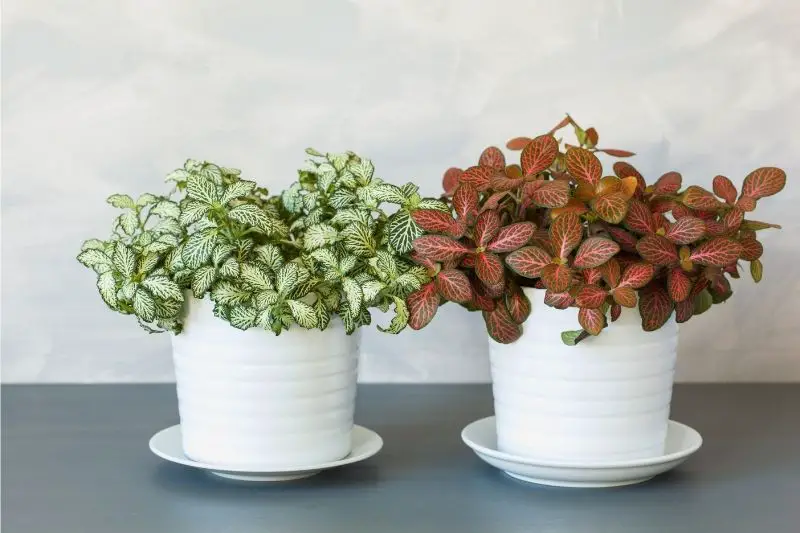
The Nerve Plant, commonly known as the Mosaic Plant, is a common houseplant that does great in terrariums or paludariums. It gets its name from the vein-like white lines shown on the plant leaves.
The best substrate for your Nerve Plant will be one that is suited for tropical environments by retaining good moisture, but also allows for proper drainage. I would recommend standard potting soil with a peat moss base.
As the Nerve Plant is a foliage plant, it can provide some great coverage in the background of your paludarium. Nerve plants do best in bright, indirect light and in environments with lots of moisture. This is why a paludarium is the perfect fit!
| Common Name | Nerve Plant |
| Scientific Name | Fittonia Albivenis |
| Environment Type | Terrestrial |
| Plant Type | Houseplant |
| Placement | Background |
Below is a short list of additional terrestrial houseplants that could also be used in a Paludarium:
- Purple Waffle (Hemigraphis Alternata)
- Dragons Tongue (Hemigraphis Repanda)
- Friendship Plant (Pilea Involucrata)
- Corkscrew Rush (Juncus effusus ‘Spiralis’)
- Laceleaf (Anthurium Spp.)
- Dumb Cane/Leopard Lily (Dieffenbachia Spp.)
- Parlor Palm (Dwarf Palm Neanthe Bella)
- Prayer Plant (Nymphaea Stellata)
- Dwarf Water Lettuce (Maranta Leuconeura)
- Croton spp (Croton spp)
- Spider plants (Chlorophytum comosum)
- Wandering Jew (Tradescantia zebrina)
22. Earth Star (Cryptanthus)
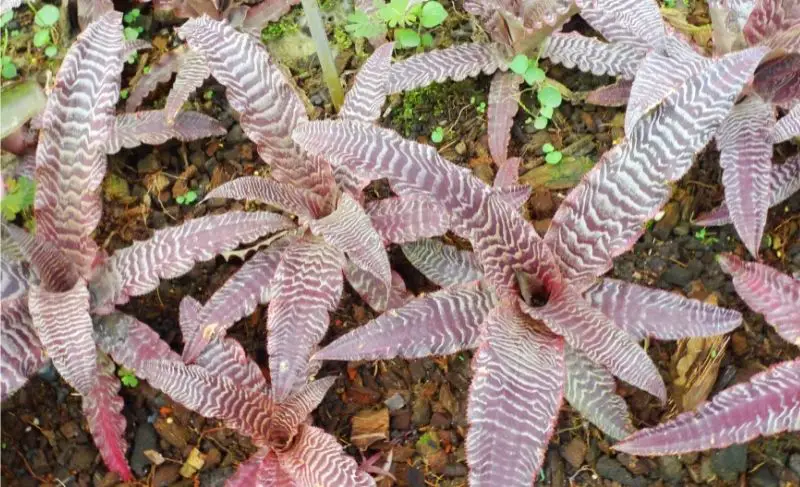
The Earth Star (Cryptanthus) is great for paludariums as they often hold moisture which creates homes for a variety of wildlife from insects to amphibians. They are a great tropical plant and would do great for any habitat that contains frogs.
Cryptanthus generally do best planted in a light substrate. Standard Bromeliad potting mix should be sufficient but I would also add some leaf mulch and sphagnum peat moss to help with drainage.
Although these plants love bright, indirect light, be sure not to expose them to too much light or direct sunlight as their leaves will burn and wilt. Cryptanthus can be planted pretty much anywhere terrestrial within your paludarium. They an even be mounted if your paludarium setup is big enough!
| Common Name | Earth Star |
| Scientific Name | Cryptanthus |
| Environment Type | Terrestrial |
| Plant Type | Bromeliad |
| Placement | Anywhere |
Below is a short list of additional terrestrial bromeliads that could also be used in a Paludarium:
- Neoregelia spp. (Neoregelia spp.)
- Billbergia spp. (Billbergia spp.)
- Vriesea spp. (Vriesea spp.)
- Aechmea Spp. (Aechmea Spp.)
23. Braided Orchid (Lockhartia)
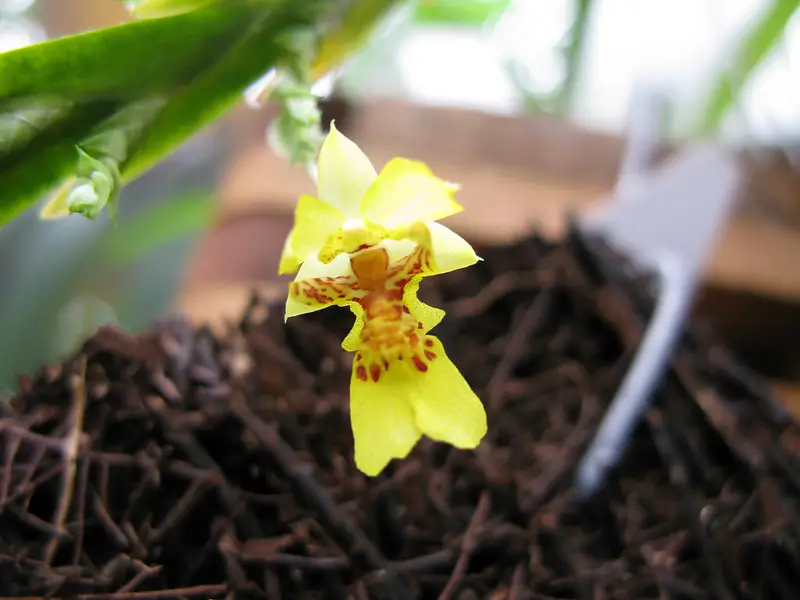
The Braided Orchid is a really great choice if your looking to add some bright colors to your paludarium. The flower petals are bright yellow and contain a reddish, orange pattern on the inside of the orchid. These orchids can be either planted in soil or mounted, so you have plenty of options when thinking about placement.
The Braided Orchid generally does best planted in a loose, airy substrate. The peak bloom periods for this orchid are between March and October, so be sure it gets plenty of water during those times. Outside of peak season, you don’t need to water your orchid as much, just be sure you water enough to prevent it from drying out.
| Common Name | Braided Orchid |
| Scientific Name | Lockhartia |
| Environment Type | Terrestrial |
| Plant Type | Orchid |
| Placement | Anywhere |
Below is a short list of additional terrestrial orchids that could also be used in a Paludarium:
- Tillandsia stricta (Tillandsia stricta)
- Phalaenopsis fasciata (Phalaenopsis fasciata)
- Dendrobium spp. (Dendrobium spp.)
- Masdevallia spp. (Masdevallia spp.)
- Oncidium spp. (Oncidium spp.)
- Laelia spp. (Laelia spp.)
- Cattleya Spp. (Cattleya Spp.)
- Dracula Spp. (Dracula Spp.)
- Lepanthes Spp. (Lepanthes Spp.)
- Moth Orchid (Phalaenopsis Spp.)
- Platystele Spp. (Platystele Spp.)
- Tolumnia Spp. (Tolumnia Spp.)
24. Peat Moss (Sphagnum Moss)
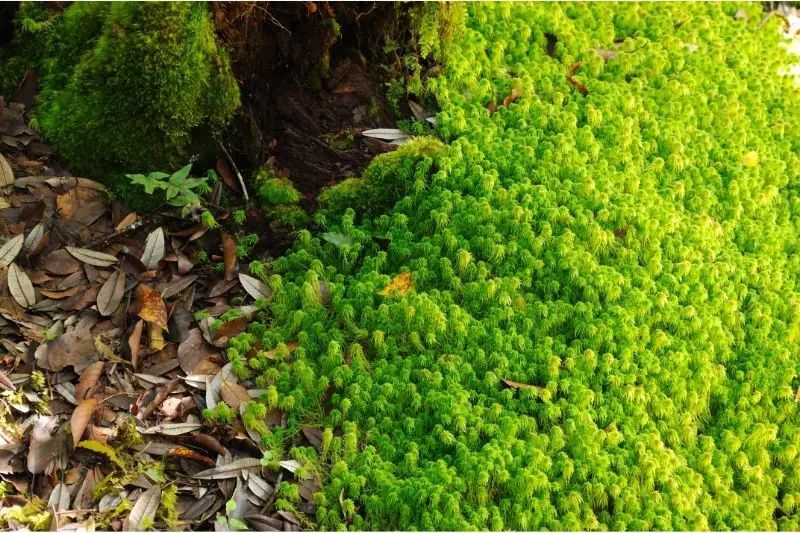
Peat Moss (Sphagnum Moss) is great for any paludarium and provides great benefits to your other plants. Sphagnum Moss is best used when mixed in with the soil or substrate of your other plants as it greatly increases water retention and helps the soild to hold on to nutrients longer.
You can also use Sphagnum Moss as a top dressing to protect new roots before they reach the medium from drying out. The benefit of adding Sphagnum Moss is that you don’t need to water as much. This moss sponge can retain water up to 20 times its dry weight and slowly releases the water over time, helping to create its own watering cycle.
| Common Name | Peat Moss |
| Scientific Name | Sphagnum Moss |
| Environment Type | Terrestrial |
| Plant Type | Moss |
| Placement | Anywhere |
Below is a short list of additional terrestrial moss that could also be used in a Paludarium:
- Club Moss (Selaginella Kraussiana)
- Delicate Fern Moss (Thuidium Delicatulum)
- Sheet Moss (Hypnum Cupresiforme)
- Mood Moss (Dicranum Scoparium)
- Feather Moss (Ptilium Crista-Castrensis)
- Star Moss (Tortula Ruralis)
- Tree Moss (Climacium Spp.)
25. Creeping Fig (Ficus Pumila)
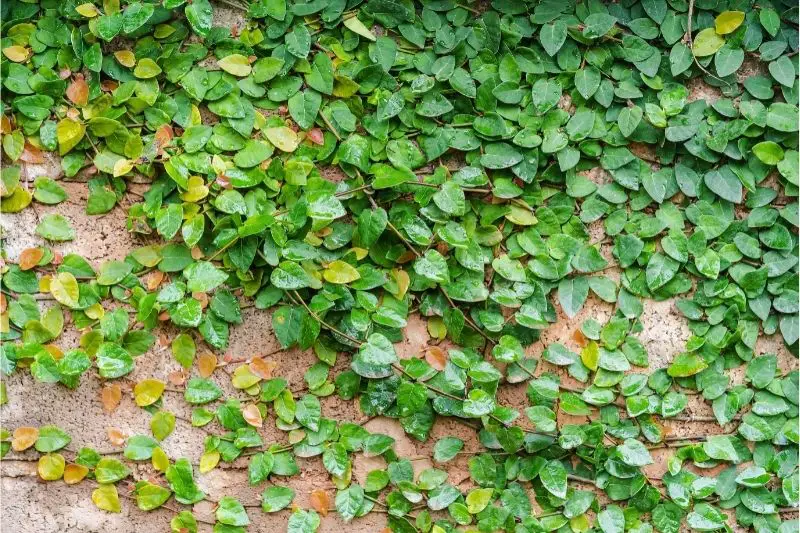
The Creeping Fig, also known as the Climbing Fig, definitely lives up to its name. The best placement for this plant in your paludarium would be in the lower background or along your tank walls to create a nice green backdrop to really enhance your tropical environment.
As the vine grows upwards, be sure you have enough room in your tank to accommodate its growth or make sure your keeping up plant maintenance and regular pruning.
The Creeping Fig adapts well to most substrates so any terrarium or standard potting mix with good drainage will be suitable.
| Common Name | Creeping Fig |
| Scientific Name | Ficus Pumila |
| Environment Type | Terrestrial |
| Plant Type | Vine |
| Placement | Background |
Below is a short list of additional terrestrial vine plants that could also be used in a Paludarium:
- String Of Pearls (Curio Rowleyanus)
- Baby Tears (Soleirolia Soleirolii)
- Satin Pothos (Scindapsus Pictus ‘Argyraeu’)
- Polka Dot Plant (Hypoestes Phyllostachya)
- English Ivy (Hedera Helix)
- Aluminum Plant (Pilea Cadierei)
- Lipstick Plant (Aeschynanthus Radicans)
- Asparagus Fern (Asparagus Setaceus)
- Radiator Plant (Peperomia Spp.)
- Trailing Jade (Peperomia Rotundifolia)
- Gobenia Section (Begonia Spp.)
- Yellow Canary (Impatiens Repens)
26. String of Pearls (Curio Rowleyanus)
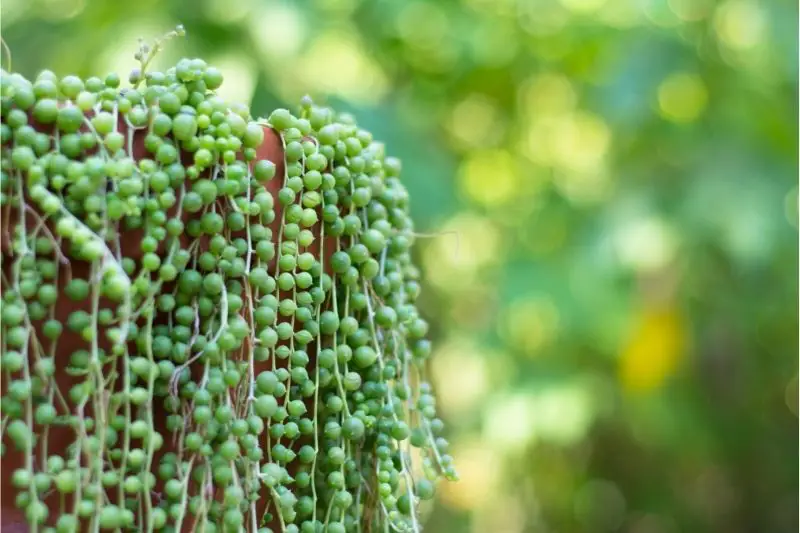
The scientific name for String of Pearls, Curio Rowleyanus, is also synonomous with Senecio rowleyanus.
String of Pearls is a type of succulent that has string-like stems with green pearl-shaped leaves. It can grow in warm, humid areas which makes it great for paludariums. Although unsafe for humans and most household pets to digest, string of pearls is safe for reptiles.
As String of Pearls are a type of succulent, they need a substrate with excellent drainage and a good mix of soil and sand.
My top choice is this Cactus Potting Mix from Amazon. Its organic and provides great drainage so that your plants are protected against root rot.
| Common Name | String of Pearls |
| Scientific Name | Curio Rowleyanus |
| Environment Type | Terrestrial |
| Plant Type | Vine |
| Placement | Background |
27. Boston Fern (Nephrolepis Exaltata)
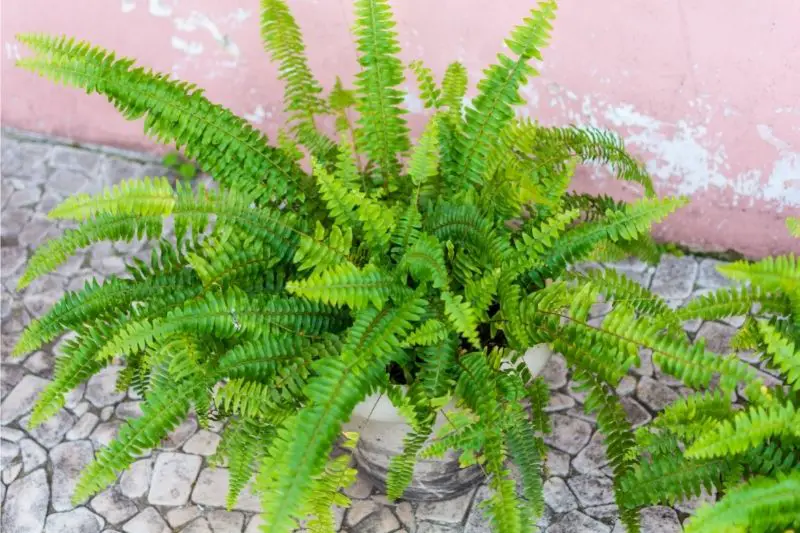
The Boston fern, also known as the Sword fern, would be great for a tropical environment, with high humidity. Originally found in humid forests or swamps, a paludarium with areas of water and pebbles is the perfect environment for this plant.
The Boston Fern is often a favorite for any paludarium or terrarium enthusiast as it does a great job with helping to remove air pollution within your tank and assist in increasing humidity levels.
The best substrate for this tropical plant is a soil mix that has great water retention and is rich in moisture and organic materials. The Boston Fern tends to prefer a more acidic soil mix with low PH levels of between 5.0 to 5.5.
| Common Name | Boston Fern |
| Scientific Name | Nephrolepis Exaltata |
| Environment Type | Terrestrial |
| Plant Type | Fern |
| Placement | Mid to Background |
Below is a short list of additional terrestrial ferns that could also be used in a Paludarium:
- Rabbit Foot Fern (Davallia Tyermanii)
- Crocodile Fern (Microsorum Musifolium ‘Crocodyllus’)
- Button Fern (Pellaea Rotundifolia)
- Silver Lace Fern (Pteris Ensiformis)
- Silver Ribbon Fern (Pteris Cretica)
- Heart Fern (Hemionitis Arifolia)
- Autumn Fern (Dryopteris Erythrosora)
- Delta Maidenhair Fern (Adiantum Raddianum)
- Lemon Button Fern (Nephrolepis cordifolia)
- Holly Fern (Cyrtomium falcatum)
Bonus Paludarium Plant List
Here you will find my compiled list of plants for paludariums that I discovered through my research. Although the plants that I suggested in the above article are my personal favorites and are most common among other paludarium enthusiasts, they are in no way the only options.
See below for over 130 other plant species that are also great options for paludariums.

Meet Brad, the creator behind Vivarium Vibes, where his deep connection with nature and animals truly comes to life.
